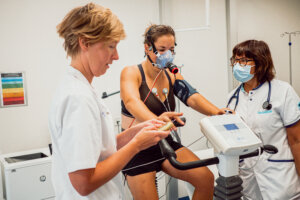Intracompartmental pressure measurement
What is it?
What is it?If we suspect a compartment syndrome, we may perform an intracompartmental pressure measurement.
A compartment (or lodge) consists of muscle bundles and is surrounded by a sheath (the fascia). When the pressure gets too high in the lodge, this gives rise to compartment syndrome. We measure the pressure in the compartments using a pressure measurement. This tends to occur in the lower leg, where there are four places that may be pricked.
- With acute compartment syndrome (e.g. after intense exercise causing the muscles to swell substantially or after a severe muscle haemorrhage after trauma), the pressure can build very quickly. This is because the muscle envelope (the fascia) is unable to expand as well. This can cause the nerves, blood vessels and muscles to become very pinched and a fasciotomy (cutting through the sheath) should be performed quickly to restore pressure in the lodge.
- With chronic compartment syndrome (CECS - chronic exertional compartment syndrome), the elevation in the lodge is dormant. Symptoms typically arise after a certain period of time at a certain level of exertion, and then disappear at rest. There is often an underlying biomechanical factor that causes the muscle to continually overload. In such a case, a gait or walk analysis may be helpful in detecting this.
What is the process?
What is the process?While taking pressure measurements, we perform a measurement at rest and one after maximal exertion to see if the pressure in the lodge is significantly elevated. To do this, we prick the lodge with a needle and read the pressure with physiological water that passes through a device. If the resting pressure exceeds 20mmHg and the pressure with exertion exceeds 30 mmHg, then a chronic compartment syndrome is likely.
Centres and specialist areas
Centres and specialist areasLatest publication date: 16/05/2024



